Puffing up is a captivating behavior observed in grackles, showcasing their unique adaptations and communication methods. This behavior involves expanding their feathers to create a visually striking display.
Puffing up serves various purposes, including courtship, communication, and territorial defense. Exploring the nature of this behavior sheds light on the intricate social dynamics of grackles.
This article will make you realize the puffing-up condition of Grackles in a comprehensive manner. So, make sure to go through each of the sections cautiously.
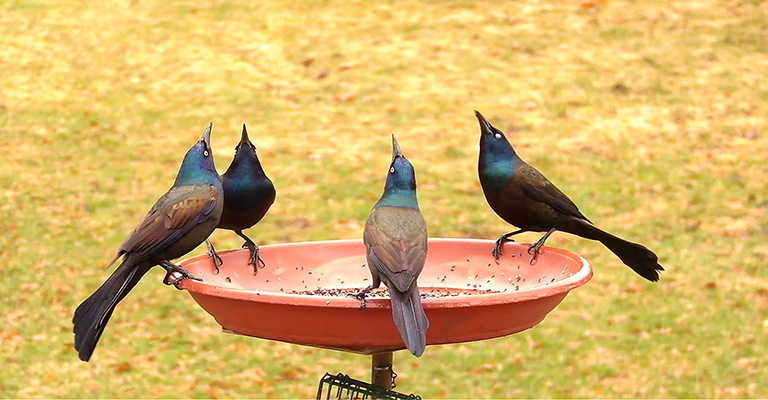
The Nature of Puffing Up in Grackles
Let’s go through some of the characteristics of puffing up in Grackles. It is important to the nature of this condition before digging deep.
Puffing Up and Its Visual Effect
When a grackle puffs up, it expands its body by inflating its feathers, creating a fuller and more voluminous appearance. The bird’s feathers stand erect, making it seem larger and more robust.
The effect is visually striking, transforming the sleek silhouette of the grackle into an impressive display of plumage. Puffing up can give the bird an air of authority and dominance, making it stand out among its peers.
When and Why Grackles Puff Up?
Grackles puff up in various situations, each with its own purpose and significance. One common reason for puffing up is communication.
Grackles are highly social birds, and puffing up is a way for them to convey information to other members of their species.
They may puff up during community calls, establishing their presence and maintaining social cohesion within the group.
Another significant context for puffing up is courtship. Male grackles often puff up to impress females during the breeding season. By expanding their feathers, they enhance their physical appearance and attract potential mates.
The larger and more majestic the display, the more likely it is to capture the attention of female grackles.
Puffing up also serves as a means of defense and intimidation. When faced with potential predators or rival males, grackles puff up to appear larger and more formidable.
This behavior is a visual signal indicating their readiness to defend themselves or their territory. By puffing up, grackles assert their dominance and deter potential threats.
Grackles puff up as a form of communication, courtship display, and defense mechanism. It is a behavior deeply ingrained in their nature, allowing them to effectively convey their intentions, attract mates, and assert their dominance when necessary.
Communication and Social Behavior
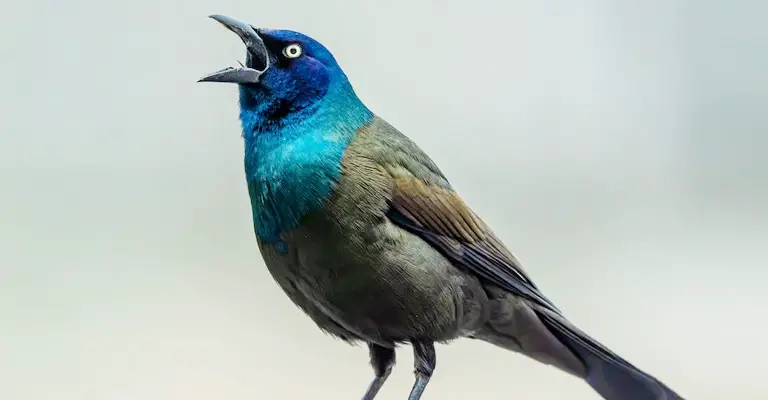
There are possible causes of the puffing up conditions and one of them is essentially communication and socialization. Read the following section to dig deep into this matter.
Grackles’ Communication Methods
Grackles utilize a combination of vocalizations, body language, and visual displays to communicate with one another. Their vocal repertoire includes a diverse range of calls, from melodious songs to harsh screeches.
These vocalizations serve different purposes, such as attracting mates, defending territories, and maintaining social cohesion within their groups.
Grackles also employ body postures, wing displays, and movements to convey messages and assert their intentions.
The Role of Puffing Up in Communication Among Grackles
Puffing up is an integral part of Grackles’ communication repertoire. When grackles puff up, it serves as a visual signal to other birds, indicating their current state or intentions.
The expanded body size achieved through puffing up can convey dominance, confidence, or aggression.
Other grackles can interpret these visual cues and respond accordingly, either by acknowledging the dominance of a puffed-up individual or by perceiving it as a threat.
Different Contexts in Which Puffing Up Occurs
Puffing up in grackles occurs in various contexts, each linked to specific social behaviors. One such context is establishing dominance within their social hierarchy.
When competing for resources or territory, grackles may puff up to intimidate and assert their dominance over other individuals. This behavior signals their readiness to engage in conflicts and serves as a display of strength and authority.
During the breeding season, puffing up takes on a different role in attracting mates. Male grackles puff up their feathers to enhance their appearance, making themselves more visually striking and appealing to females.
The impressive display of a puffed-up male can signal his genetic quality, vigor, and ability to provide for potential offspring.
Puffing up also serves as a defense mechanism against potential predators. When confronted with threats, grackles may puff up to appear larger and more intimidating, deterring predators from approaching.
Courtship and Mating Behavior
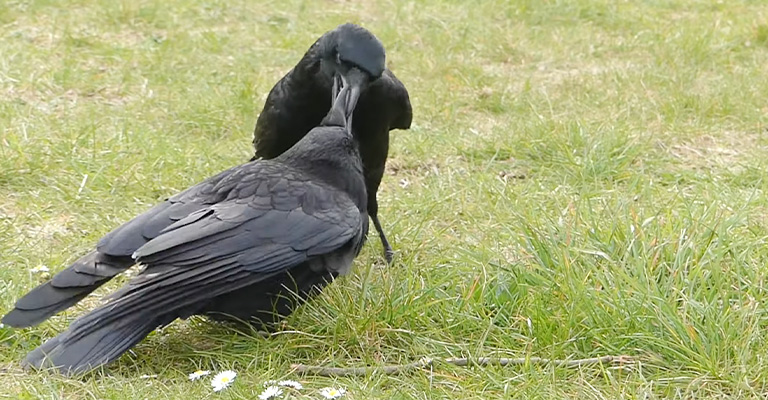
This state of grackles also indicates their urge for mating and other natural calls. Check out the following section to dissect the possible causes of your pet’s grackles.
Puffing Up as a Courtship Display
During the breeding season, male grackles engage in elaborate courtship displays to attract female grackles. Puffing up is a significant component of these displays, as it allows males to visually stand out and capture the attention of potential mates.
Through puffing up, males transform their sleek appearance into a more impressive and visually striking display that highlights their physical attributes.
How Puffing Up Enhances the Male Grackles’ Appearance
When male grackles puff up, their feathers expand, making them appear larger and more majestic. The increased size and volume of the bird’s body create a visually impressive spectacle.
Puffing up accentuates the male’s physical features, such as its iridescent plumage, elongated tail feathers, and vibrant eye color. The enhanced appearance signals genetic quality, health, and overall fitness, traits that female grackles seek in potential mates.
Potential Role of Puffing Up in Attracting Mates
Puffing up plays a crucial role in attracting mates for male grackles. By puffing up and displaying their expanded plumage, males communicate their readiness and willingness to engage in courtship activities.
The visual spectacle created by puffing up can capture the attention of nearby females, drawing them closer to observe the male’s elaborate display. It serves as a visual signal of the male’s reproductive fitness and can influence female mate choice.
Furthermore, the act of puffing up during courtship may also indicate the male’s ability to defend resources and protect the female during the nesting period.
The inflated appearance conveys a sense of strength and dominance, reinforcing the male’s suitability as a potential mate and provider.
Puffing up plays a significant role in the courtship and mating behavior of grackles. Through this behavior, male grackles enhance their appearance, visually showcasing their genetic quality and fitness to attract potential mates.
The elaborate display of puffing up serves as a powerful visual signal that can influence female mate choice and contribute to successful reproduction within the grackle population.
Vocalization and Singing Behavior
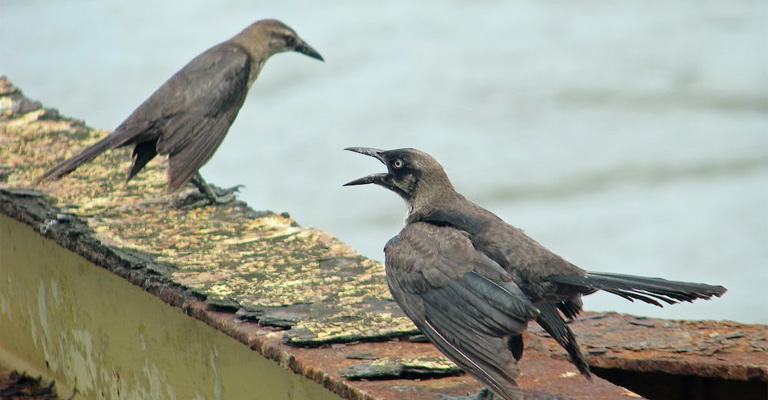
There are some factors in vocalization and singing instances of grackles. So, read out the following section to get some more information on this matter.
Relationship Between Puffing Up and Singing in Grackles
Puffing up and singing are closely intertwined behaviors in grackles. When grackles engage in singing, they often accompany their vocalizations with the act of puffing up.
The connection between puffing up and singing suggests that the physical expansion of their bodies through puffing up may have a functional role in supporting and enhancing their vocal performances.
How Puffing Up Aids in Vocalization and Song Production
Puffing up is believed to aid grackles in vocalization and song production in several ways. Firstly, by expanding their bodies, grackles create a larger resonating chamber, which can amplify the sound they produce.
This increased resonance can help their songs carry over longer distances, allowing for effective communication with other grackles in their vicinity.
Secondly, puffing up may assist in breath control and vocal modulation. The act of puffing up can provide additional support to the muscles involved in respiration, allowing grackles to produce more controlled and powerful vocalizations.
It may also help them regulate airflow and manipulate their vocal apparatus, resulting in a wider range of pitches and tones during their songs.
Observations of Puffing Up During Singing
Observers have documented numerous instances of grackles puffing up during their singing behavior. When grackles prepare to sing, they often puff up their feathers just before vocalizing.
This behavior is particularly noticeable in male grackles during the breeding season when they are actively engaging in courtship displays and competing for mates. The combination of puffing up and singing creates a captivating visual and auditory display.
Male grackles puff up their feathers, making themselves appear larger and more visually striking, while simultaneously producing a range of vocalizations, from melodious warbles to piercing whistles.
This coordinated display of puffing up and singing serves as a multifaceted communication strategy, allowing male grackles to advertise their presence, establish territory, and attract potential mates.
Other Potential Functions of Puffing Up
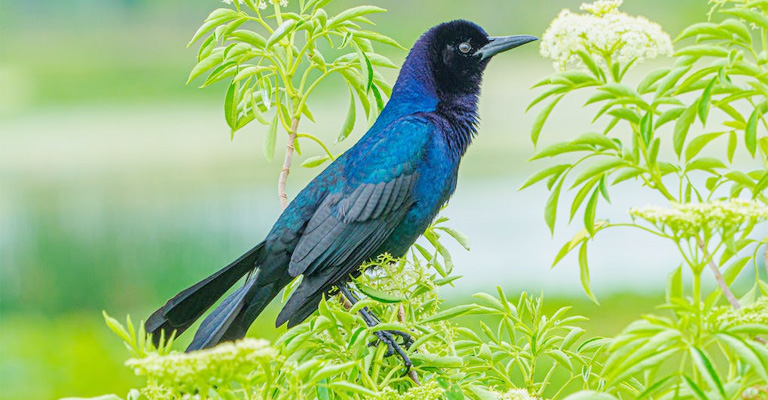
Apart from the mentioned instances in the previous phases, there are some other functions of puffing up. These additional points written below will shed more light on the condition.
Temperature Regulation and Insulation
Puffing up in grackles can serve as a mechanism for temperature regulation. By fluffing up their feathers, grackles create an insulating layer of air that helps to retain body heat during colder periods.
This adaptation is particularly important for grackles living in cooler climates or during chilly weather conditions.
By puffing up, grackles can minimize heat loss and maintain a more favorable internal body temperature, increasing their chances of survival and overall well-being.
Visual Displays and Territorial Behavior
Puffing up plays a significant role in visual displays and territorial behavior among grackles. When establishing territories or defending their nesting sites, grackles may puff up to appear more prominent and intimidating to intruders.
The expanded body size and enhanced appearance can act as a visual deterrent, communicating their ownership and readiness to protect their territory.
Puffing up in this context serves as a signal of aggression and asserts their dominance within the social hierarchy.
Potential Benefits of Puffing Up
Puffing up in grackles provides selective advantages and potential benefits that contribute to their overall fitness.
Firstly, by puffing up, grackles can increase their visibility to conspecifics, facilitating communication and social interactions within their groups.
It allows individuals to convey information about their intentions, status, and readiness for various behaviors, such as mating, defending resources, or engaging in communal activities.
Additionally, puffing up can confer a sense of confidence and dominance, potentially influencing the behavior of other grackles.
Individuals that can effectively puff up and project a formidable appearance may gain advantages in competing for mates, and resources, or defending against potential predators.
The ability to puff up and display their size and presence can give grackles an edge in these competitive situations, increasing their reproductive success and overall survival rates.
Functions and Contexts of Puffing Up in Grackles
| Function/Context | Description |
| Communication | Puffing up is part of Grackles’ communication repertoire, used to convey information to conspecifics. |
| Courtship and Mating | Puffing up is a courtship display, enhancing the male grackles’ appearance to attract potential mates. |
| Vocalization and Singing | Puffing up aids in vocalization and song production, amplifying sound, and supporting breath control. |
| Temperature Regulation | Puffing up helps grackles regulate body temperature, providing insulation during colder weather. |
| Visual Displays | Puffing up is used in visual displays to assert dominance, deter intruders, and establish territories. |
| Selective Advantages | Puffing up provides selective advantages in competing for mates, and resources, and defending territories. |
FAQs
Both male and female grackles can puff up. While puffing up is commonly associated with male grackles during courtship displays, females may also puff up in various contexts, such as establishing dominance, defending territories, or during vocalizations.
Puffing up is not limited to a specific gender and can be observed in both male and female grackles.
Yes, there can be variations in the extent and intensity of puffing up among grackles. Factors such as individual differences, social context, and specific behaviors being performed can influence the degree of puffing up.
For example, during intense territorial disputes, grackles may puff up more extensively to appear larger and more threatening, whereas, during casual communication or mild courtship displays, the puffing up may be less pronounced.
Puffing up in grackles can have a defensive aspect to it. When confronted with potential predators, grackles may puff up as a display of intimidation and appear larger, potentially deterring the predator from approaching or attacking.
The expanded appearance, combined with vocalizations or aggressive postures, can serve as a warning signal to predators, indicating that the grackle is ready to defend itself.
Puffing up is a behavior observed in various bird species, although the specific contexts and functions may vary. Many bird species puff up their feathers for temperature regulation, insulation, or to appear more prominent during courtship displays and territorial defense.
Examples of species that exhibit puffing-up behavior include blackbirds, starlings, pigeons, and certain species of sparrows. Each species may have its own unique variations and purposes for puffing up.
Conclusion
In conclusion, grackles puff up for a variety of reasons, all serving essential purposes in their behavior and survival.
Puffing up their feathers helps regulate body temperature by trapping air and creating insulation. It also serves as a visual display, signaling aggression or dominance to other grackles, while intimidating potential predators.
Puffing up can also be a part of courtship displays, attracting mates through impressive size and colorful plumage. Additionally, grackles may puff up when feeling threatened or alarmed, making themselves appear larger to intimidate potential threats.
The act of puffing up is a complex behavior in grackles, encompassing a range of functions from thermoregulation to communication and defense mechanisms.